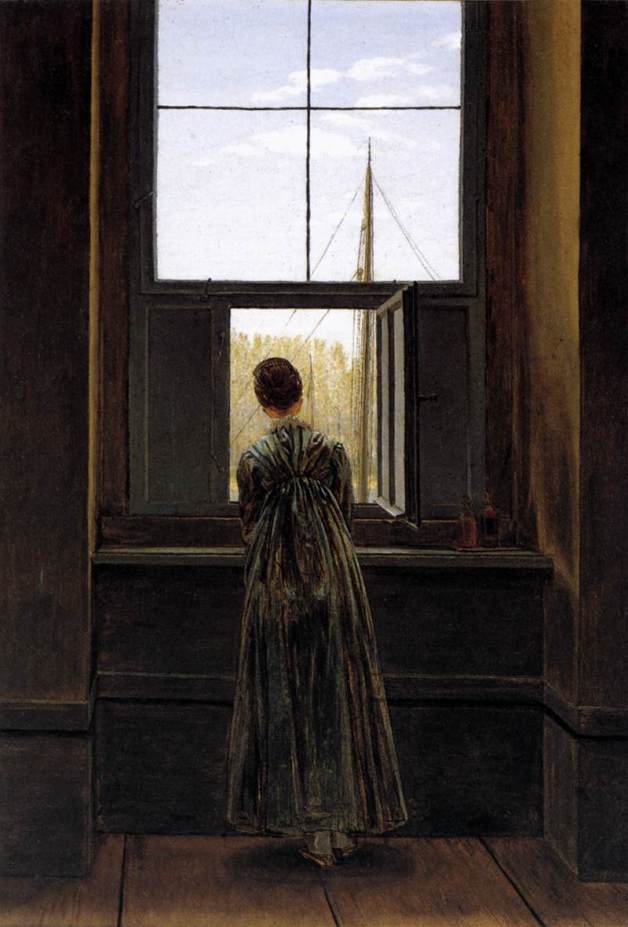De Profundis


Woman at a Window by Caspar David Friedrich
As the poet, I’m hoping to let the poem speak for itself. A note, however, about the fun Oulipo form: I find that these poems often write themselves in ways that surprise me. The links provide images and vocabulary that demand the creation of fresh poetic connections. It’s a useful form for breaking out of mental ruts or through blocks; because it does double duty by encouraging both free association and verbal problem-solving, it feels like activating multiple regions of the brain. You can find the rules for it here.
They ask how she grin through that face with that life.
I say I’s never shielded from nothing
‘Cept dying young.
People deep bruised by something
Talk like the world should end.
Won’t catch me dying every day like that.
‘Cause I seen them once
Just once – the cracks in the universe –
Thought I’d fall right through.
‘Stead I laughed – said some kind of God
Put up with a tattered-old place as here
Gotta have some grace for me.
– Jenn Cavanaugh
originally published in America, August 13, 2007

Despising the Pain: A Pantoum by Jenn Cavanaugh
I face death every day
For the joy that is set before me.
Dust returns. Death loses the fray –
The happy end begins the story.
For the joy that is set before me
I ride the eternal like a tide.
The happy end begins the story –
We’ll wear our spirits on the outside.
I ride the eternal like a tide,
Dizzied and spun, despising the pain.
We’ll wear our spirits on the outside
For the work that is not in vain.
Dizzied and spun, despising the pain,
Dust returns. Death loses the fray.
For the work that is not in vain
I face death every day.
Poor blog, doomed respository for my second-tier poems. I post this one as an example to accompany yesterday’s Writers Workshop post on the pantoum form, so you can see what you can get out of working in the form in short order. It’s only the third or fourth one I’ve ever written, and the results still feel blocky, compared to writing in unrhymed free verse. If you get something out of the theme or a phrase, I’m glad. Otherwise, this is what a writing exercise looks like!
So far, the best part of writing pantoums is that they practically write themselves – you put a couple of lines together, give them a flick, and you have a perpetual motion poetry machine. For me, they are line-generators. You put a line in, you get a line out, because the form is going to take you there. To write one that stands up as fine poetry, like the one I’ll leave you with here, I will probably have to give up the rhyme, as she did, make my lines more grammatically creative, and incorporate more narrative detail. A pantoum doesn’t have to tell a story, but the ones that appeal to me most suggest one. Do you have a favorite or one of your own to share?
Stillbirth by Laure-Anne Bosselaar
On a platform, I heard someone call out your name:
No, Laetitia, no.
It wasn’t my train—the doors were closing,
but I rushed in, searching for your face.
But no Laetitia. No.
No one in that car could have been you,
but I rushed in, searching for your face:
no longer an infant. A woman now, blond, thirty-two.
No one in that car could have been you.
Laetitia-Marie was the name I had chosen.
No longer an infant. A woman now, blond, thirty-two:
I sometimes go months without remembering you.
Laetitia-Marie was the name I had chosen:
I was told not to look. Not to get attached—
I sometimes go months without remembering you.
Some griefs bless us that way, not asking much space.
I was told not to look. Not to get attached.
It wasn’t my train—the doors were closing.
Some griefs bless us that way, not asking much space.
On a platform, I heard someone calling your name.
PANTOUM
A pantun is a traditional Malay form of quatrain-based poetry. Victor Hugo introduced it to France in 1829, calling it pantoum. The westernized pantoum descended from a specific form: pantun berkait, which repeats whole lines in an interlocking pattern. The second and fourth lines of any stanza become the first and third lines of the stanza that follows. In the pantoum's last stanza, the first and third lines of the opening stanza are finally repeated as the fourth and second lines. The order of those lines can be reversed, but ideally a pantoum will end with the poem's opening line, creating a kind of circle. Pantoums are not required to rhyme, but most do. They can vary from two stanzas to as many as you wish to write.
Composing a pantoum is a great writing warm-up. You first write a stanza of four lines. The pantoum will work best if the lines are fairly intact, evocative phrases of similar length or rhythm -- each expressing just one basic idea or image that can resonate in different ways when placed in a new context, as they will be throughout the poem. Most of your work in setting the tone and sense goes into laying this foundational stanza, because by the second stanza, you’ll see the poem start to take on a life and significance of its own, while you just follow along or nudge it into shape with an additional line here and there. Allow the wave-like quality of the form to carry you along. Be spontaneous. Allow for happy accidents and juxtapositions. Once you get to the end you’ll probably need to go back and edit a couple of lines to fit into the rhythm that’s developed. This form demonstrates the power of the line. If you have an old poem lying about that isn’t working, but some of the lines are keepers, or an orphaned line running through your head, start a pantoum with one of those lines. This works especially well for couplets that start to sound a bit sing-songy; the pantoum form aerates them – giving breathing space between the rhymes and finding depth in the repetitions. This also works in reverse, as your pantoum might generate one perfect line that starts a whole new piece. Writing a poem in any form is a challenge. Give it what you have today. There might be a glaring hole or clunky line that you know you need to come back to. Start a new project and go back to this one next week when you can hear the poem as a whole with fresh ears and respond accordingly. Getting started is as easy as copying and printing the form below. Stuck for a first line? Scroll down further for some ideas there. Make it rhyme ABAB and it will start writing itself after that.
_________________________________________________________________ (Line 1)
_________________________________________________________________ (Line 2)
_________________________________________________________________ (Line 3)
_________________________________________________________________ (Line 4)
_________________________________________________________________ (Line 2)
_________________________________________________________________ (Line 5)
_________________________________________________________________ (Line 4)
_________________________________________________________________ (Line 6)
_________________________________________________________________ (Line 5)
_________________________________________________________________ (Line 7)
_________________________________________________________________ (Line 6)
_________________________________________________________________ (Line 8)
_________________________________________________________________ (Line 7)
_________________________________________________________________ (Line 3)
_________________________________________________________________ (Line 8)
_________________________________________________________________ (Line 1)
I find this a very meditative form. The wave-like structure encourages movement in place, like something caught in the tide just off shore. The water churns up deeper layers, but by definition you end up where you began. You swirl around a thought until you come to rest. If you have a phrase, mantra, or story that just won't let you go, maybe it's a pantoum.
When I introduced this form at church for a Lenten devotional writing class, I suggested starting with a biblical phrase...
Ideas for opening lines/ texts:
“Dust you are and to dust you will return”/ Genesis 3
“Do not put the Lord your God to the test”/ Matthew 4
“[And afterward] I will pour out my spirit on all people”/ Joel 2
“This inheritance is kept in heaven for you”/ 1 Peter 1
“Revive us, and we will call on your name”/ Psalm 80
“You will be like a well-watered garden”/ Isaiah 58
“Work out your salvation with fear and trembling”/ Philippians 2
“It is written about me in the scroll”/ Hebrews 10
“He loved them to the end”/ John 13
“She has done a beautiful thing to me”/ Matthew 26
Give it a try! I’ll post the results of my writing exercise tomorrow, as well as a much finer example.
To the Tune of “The Lilies of the Covenant:” A Haibun
by Jenn Cavanaugh
(Yesterday I posted about the haibun form. I wrote this one for our church’s Lenten Devotional to accompany Psalm 80.)
Restore us, O God
make your face shine on us
that we may be saved
– Psalm 80:3
Scripture often compares us to grass, to flowers, to trees. We are plants of the field, of the garden, of the wilds – rambling, bristling roses; burning, flowering bushes; a host of succulents storing water in the driest deserts; swaying oasis palms flagging hidden sources of water; tumbleweeds that mark the sand and frame the next generation of climbing plants. We sprawl through the wilderness toward a land of streams, a land cleared of everything that doesn’t yield fruit.
Consider the vine
without fangs or teeth or arms
it survives nations
The strength of a vine is its tenacity in springing back, in adapting to the place it is planted. The terms of its survival are unconditioned – a mark of the people of the God who preserves and glories in faithful remnants. The vine’s response to being trampled is to renew its grip on the good earth, anchor itself with the buried tendrils, and keep growing. When cut back mercilessly, the broken bits form new shoots. The vine’s long stems are designed to break new ground and cover it, not to stand on their own. One lonely strand epitomizes the frail, but as a whole it establishes itself in heaps, disregards artificial limits, surmounts impediments, drapes itself lightly over inhospitable terrain, and clambers toward the sun at every opportunity.

Rooted in motion
Runners commit to earth and sky
Morning glory
Once or twice a year I’ll put together a guided writing workshop for our adult education time at church. I’ve found that introducing different forms and themes each week limbers us up to experiment with something new and gives us a nudge to get started rather than staring at blank sheets of paper. No one feels the need to write something expert in a form they’ve never encountered before or on a subject they just started thinking about five minutes ago. The writing is fresher, and people are consistently surprised by what they come up with. I think I have enough material to share at this point that I’ll make my intros to these forms and themes into their own “Writers Workshop” category.
The haibun form combines haiku and prose poetry. Originally it was a form of travelogue or journal writing. Writers pause in their poetic narrative or description of an event, person, place, or thing to compose a haiku that captures the emotions of their experience or encounter. The effect is that of a transfer of memory, whether real or imagined. The descriptive narrative evokes the senses with concise, poetic langauge, usually in the present tense, drawing the reader into a dreamy immediacy. The haiku functions to further the narrative or comment on it through summary or juxtaposition. Good haibun, like haiku, favors impressionism over abstraction. Don’t muse about how children grow up and leave us. Tell me about how your hand, now stuffed in a pocket, used to be both colder and warmer holding hers in this park. Then show me the indentation in the grass of the empty nest.
There are many examples to be found at Contemporary Haibun Online, and I’ll post one I wrote tomorrow.